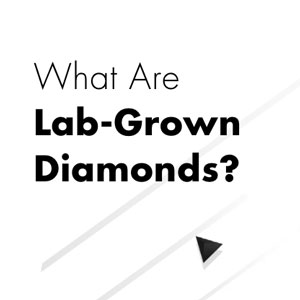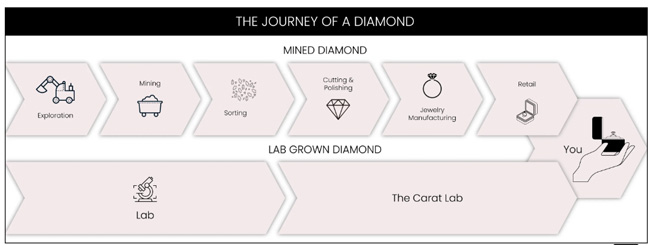
The great wave of new online retailers selling lab-grown diamonds and lab-grown diamond jewelry isn’t slowing down. In fact, it can seem (at least from an editor’s perspective) like there’s a new lab-grown diamond e-comm debuting every week.
With so many new players flooding the scene, it’s hard for startups to stand out. Which is when a company’s marketing becomes important. A new brand’s look, message, and vibe can extricate it from the tangle of competitors in consumers’ minds.
The Carat Lab, a new direct-to-consumer retailer of lab-grown diamond jewelry founded by husband-wife team Vivek Baid and Kavika Daga-Baid, caught my attention this week with a beautifully designed website page simply entitled “What Are Lab-Grown Diamonds?” The educational portal is just the kind of “extra” I think modern diamond jewelry shoppers are craving.
Of course most lab-grown retailers have a page that covers this topic—it’s clear that when it comes to lab-growns, consumer education is a necessity. “Is it real?” is a common first question from shoppers, many retailers have told me.
Also, budget-conscious consumers will often pivot toward lab-grown diamonds when they hear how they are the same and different from mined stones. Veeral Rathod, CEO of Spence Diamonds, which sells lab and mined diamonds side by side, told me earlier this year, “Once customers are educated on what lab-created diamonds are, we’re seeing an 80 percent-plus conversion rate.”
But the Carat Lab’s education portal is especially robust, and in my view answers every conceivable question a buyer could have about what a lab-grown diamond is, how it’s made, and what makes it different from a mined diamond.
The page packs some good-and-nerdy history of manufactured diamonds as an industrial element: “Lab-grown diamond success has impacted industrial growth effecting major end-use segments like construction and electronics. These diamonds can be used in cutting, drilling, polishing and have excellent thermal and electrical properties and can be used as conductors.”
There are also graphs and charts that cover topics including the chemical composition of lab versus mined diamonds and a video cribbed from The Wall Street Journal that shows how lab-grown diamonds are made. That sits alongside a blurb that distills the growing process: “Labs use pressure and temperature to dissolve ground carbon into a diamond seed and then layering that seed with carbon and sealing it into a vacuum chamber produces a new stone over just a few short weeks.”


Carat Lab cofounder Vivek Baid says the extensive education is important to the company’s marketing and sales efforts because it works to quash misinformation about lab-grown diamonds. “There are obvious biases in our industry that will try and reduce the value proposition of lab-grown diamonds,” he says, “but we are here to tell folks how it really is. Lab-grown diamonds are real diamonds, just simply created in a lab.”
He adds, “Anyone purchasing it should understand that because it wasn’t mined, doesn’t make it fake or synthetic. It’s been far too long where consumers have had to pay top dollar for diamond jewelry and likely not get anywhere near the value they are actually paying for.”
For sure, the Carat Lab’s lab-grown diamond jewelry is competitively priced. Sterling silver hoop earrings studded in 1/8 ct. t.w. diamonds go for $230, while a two-stone silver ring with 1.165 cts. t.w. diamonds sells for $2,022.
“The consumers have a right to know that although diamonds are high in value, they aren’t as rare as marketers—and our industry folks—make them out to be,” says Baid. “In essence, we are trying to demystify the jewelry-buying experience. The content is pretty easy when you’re not trying to hide anything.”
Top: The headline for the Carat Lab’s diamond education page (all images courtesy of the Carat Lab)
- Subscribe to the JCK News Daily
- Subscribe to the JCK Special Report
- Follow JCK on Instagram: @jckmagazine
- Follow JCK on X: @jckmagazine
- Follow JCK on Facebook: @jckmagazine